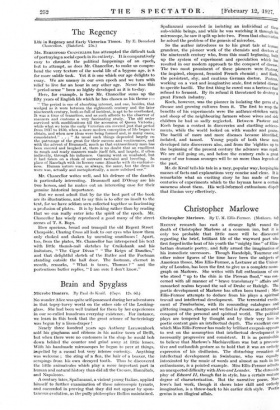The Regency
Life in Regency and Early Victorian Times. By E. Beresford Chancellor, (Bateford. 25e.) Ma. BERESFORD CHANCELLOR has attempted the difficult task of portraying a social epoch in its entirety. It is comparatively easy to chronicle the political happenings of an epoch, but to attempt, as does Mr. Chancellor, to make us compre- hend the very texture of the social life of a bygone age, is a far more subtle task. Yet it is one which our age delights to essay. We are uneasy in our own epoch and we turn with relief to live for an hour in any other age. Never has this " period-sense " been so highly developed as it is to-day.
Here, for example, is how Mr. Chancellor sums up the fifty years of English life which he has chosen as his theme :—
" The period is one of absorbing interest, and one, besides, that wedged as it were between the eighteenth century and the later nineteenth century, both so full of incident, is apt to be overlooked. It was a time of transition, and as such affords to the observer of manners and customs a very fascinating study. The old order survived with modifications till the accession of Queen Victoria ; while what we term the early Victorian era covered just that period from 1837 to 1850, when a more modern conception of life began to obtain, and when new ideas were being formed and, in many cases, consolidated." . . . " As usual such things depended largely on the patronage of the great for their success and continuance, and with the advent of Brwnmell, much as that extraordinary man has been sneered and laughed at, there is no doubt that an emollient to rough and ready manners made itself felt, and largely, if often indirectly, through his influence. Gaming went on unabated, but it had taken on a cloak of outward restraint and breeding. In place of Ranelagh with its licence came Almacks with its exclusive- ness. Human nature was, as always, the same, but the dress it wore was, actually and metaphorically, a more subdued one."
Mr. Chancellor writes well, and his defence of the dandies is particularly interesting. Brummell and D'Orsay are his two heroes, and he makes out an interesting case for their genuine historical importance.
But we must admit that by far the best part of the book are its illustrations, and to say this is to offer no insult to the text, for we have seldom seen collected together so fascinating a profusion of plates. It is by looking rather than by reading that we can really enter into the spirit of the epoch. Mr. Chancellor has wisely reproduced a good many of the street scenes of T. S. Boys.
How spacious, broad and tranquil the old Regent Street Cheapside, Charing Cross all look to our eyes who know them only choked and shaken by unending omnibuses ! Apart, too, from the plates, Mr. Chancellor has interspersed his text with little thumb-nail sketches by Cruikshank and his imitators, " The Cigar Divan " " The Reign of Dandies," and that delightful sketch of the Butler and the Footman standing outside the hall door. The footman, cheroot in mouth, remarks, " What is taxes, Thomas ? " and the portentious butler replies, " I am sure I don't know."










































 Previous page
Previous page